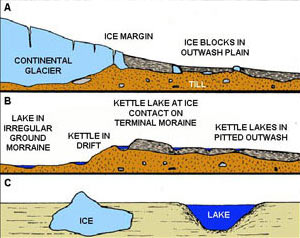"Still" (Lentic) Waters
Lentic systems generally include lakes and ponds. A lake's structure has a significant impact on its biological, chemical, and physical features. Some lentic systems may be fresh water bodies, while others have varying levels of salinity (e.g., Great Salt Lake). Most basin-type wetlands are also generally grouped within lentic systems; these are areas of constant soil saturation or inundation with distinct vegetative and faunal communities. Lakes and ponds are almost always connected with streams in the same watershed, but the reverse is not nearly as often true.
The method of lake formation is the basis for classifying different lake types. Natural processes of formation most commonly include glacial, volcanic, and tectonic forces while human constructed lakes are created by dams or excavation of basins. In his classic review of lake types, Hutchinson (1957) describes 76 different types of lakes. Of the processes that form these lakes, glacial activity has been the most important mechanism for their formation in North America. Although on human time scales we may think of lakes as permanent, they are ephemeral features on the landscape. They are found in depressions in the earth's surface in regions where water is available to fill the basin. Over time, lakes fill with sediments and organic material while outlets tend to erode the lake rim away.
Areas referred to as lake districts contain lakes created by similar processes. While the individual lakes in a lake district often share similar geologic features, the lakes themselves are often quite unique. In Northern Wisconsin and Minnesota for example many of the lakes were formed by the same glacial processes, but the individual biological, chemical, and physical characteristics of lakes even just a few miles apart can be dramatically different. In these lakes, landscape position of the basin, characteristics of the watershed, and morphometry of the basin are usually more important than method of basin formation for describing the biological features of a lake.
![[logo] US EPA](https://www.epa.gov/epafiles/images/logo_epaseal.gif)
